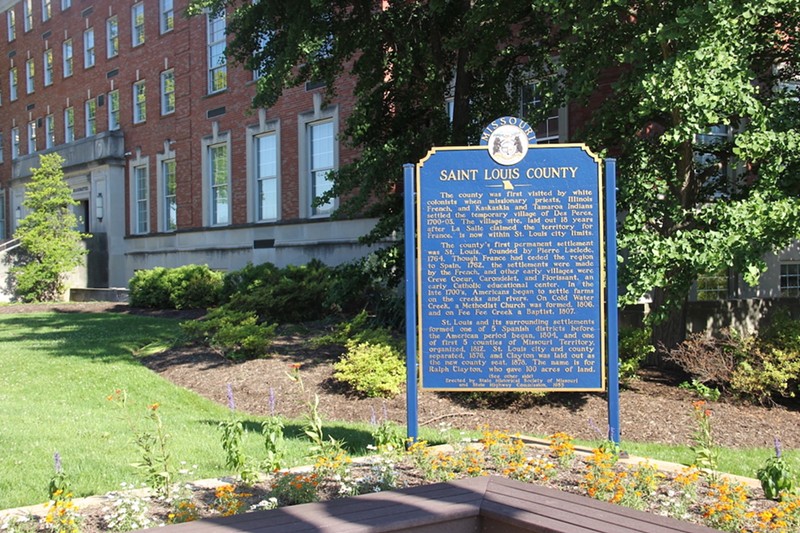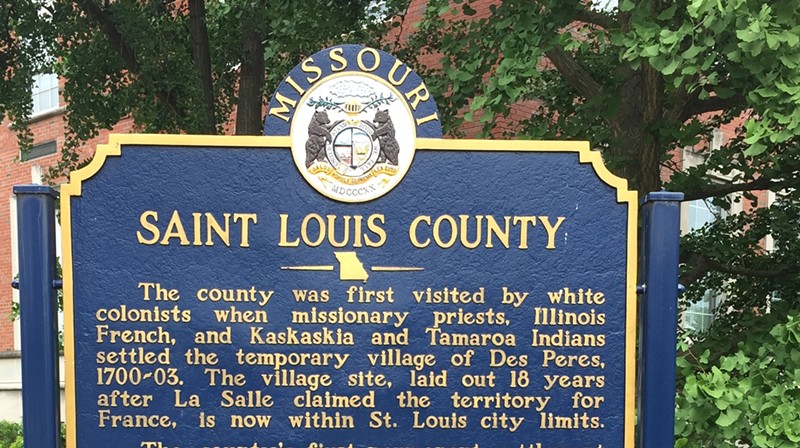
GEOFF WARD
This historical marker commemorated when white settlers first arrived in St. Louis County and was quietly removed in November.
St. Louis County has quietly removed a historical marker noting the date when “the county was first visited by white colonists” — but one of the people who advocated for its removal isn’t happy with how it happened.
Geoff Ward, a professor of African and African-American studies at Washington University, believes the county’s quiet removal, without public conversation or publicity, was a missed opportunity: “It was taken down in a way that deprives the community of an opportunity to reflect on the meaning of its removal.”
Ward remembers seeing the sign not long after he arrived in St. Louis in 2018 to start his faculty position. He was shocked.
“The marker was very explicitly identifying St. Louis County as a place where history begins with the presence of white people. And I think that is a very obviously racialized way of framing history,” he explains.
According to Esley Hamilton, the former county historian, the marker was once outside of the Clayton Community Center near Clayton High School and was part of a series of markers put up by the State Historical Society of Missouri. Clayton took down the sign and stored it in a closet in the community center, but when the community center was about to be demolished, the county took possession of the sign and eventually put it up at the corner of Forsyth Boulevard and Meramec Avenue.
Ward says the timing of the marker is noteworthy. “This marker was erected in 1955, a year after the Supreme Court holds that segregation is unconstitutional… in these moments [of liberal reform] you get this backlash in the form of reactionary measures, including the establishment of racist commemorative objects.”
Since the sign was in Clayton, Ward initially wrote to its municipal leadership about the issue. By then it was 2020, and protesters across the country were tearing down offensive monuments and markers in response to police killing George Floyd. Clayton, which had started an equity commission, looked into Ward’s suggestion only to realize St. Louis County actually owned the marker.
In mid-June 2020, Clayton and Ward brought the marker to the attention of the county, which had recently announced it would do a review of “oppressive symbols,” such as street names, statues and historical markers.
Doug Moore, spokesperson for the county, says the review came in response to Tower Grove Park removing its statue of Christopher Columbus. A web portal was set up so people could submit symbols for consideration, and Ward was asked to serve on a committee to assess the symbols.
But Ward says the committee never met. Ward believes, and Moore confirmed, that it was because the late Hazel Erby — who had been director of diversity, equity and inclusion for the county — was fired in August of 2020. (Erby later sued the county, outlining complaints with County Executive Sam Page and alleging her dismissal violated the state’s whistleblower protection statute.)
Moore, the county spokesperson, says Erby’s dismissal and larger concerns about the pandemic meant the county “didn’t focus a lot of attention on how to proceed” with removing the offensive symbols.
“This was at a time when people were tearing down monuments and moderates, conservatives and liberals were saying, ‘Well, yes they should be removed, but do it the right way.’ Don’t use vandalism,” Ward recalls. Yet after Ward went through the proper channels, the sign still "sat there for a couple years.”
Ward remembers following up from time to time about the marker. Meanwhile, others had submitted complaints through the portal. According to the Post-Dispatch, Page himself brought up Dorsett Road, which is named after Walter H. Dorsett, a farmer who, according to the 1860 census, owned 28 slaves. Another complaint was that Lee and Jackson avenues in Clayton and University City are named for Confederate Civil War generals Robert E. Lee and Stonewall Jackson.
Then, last November, two years after Ward’s complaint, the parks department quietly removed the marker and put it in storage.
Moore says that there was no press around removing the marker because “we just didn’t think that was really a priority.” He adds that county leaders are “happy it was removed.”
Still, Ward speculates that the county’s silence around the removal benefited the people in power. If the county had come out and said that the marker was racist, they may have gotten pushback.
“Some would attach labels like critical race theory to [taking down the marker],” he says. “There’s an element of whiteness that requires a commitment to evasion and self-deception on matters of race. For many, there’s an inability to acknowledge the problem of structural racism.”
Moore says the county isn't sure what will happen with the sign. “Instead of destroying it, people are wondering if it would make sense to preserve that for some kind of exhibit down the road.”
Moore adds that the county is still reviewing oppressive symbols submitted by members of the public, but there weren’t many and the process is internal. The committee Ward was invited to be on has still never met.
Moore notes that the county has renamed a shelter in the military cemetery Jefferson Barracks Park that was named after Robert E. Lee. Now, it honors the Buffalo Soldiers.
Even so, renaming streets like Dorsett Road is a different matter. “That’s a major street that can run through several municipalities and it can also have several hundred addresses assigned to it,” Moore explains. “So if you had a business or lived on that street, your address would change.”
But, Moore continues, “We will continue looking at symbols and hopefully there’s not many others out there.”
This is not the first time that the white settlers marker has been in a closet. The question now is whether this time it will stay there.
Coming soon: Riverfront Times Daily newsletter. We’ll send you a handful of interesting St. Louis stories every morning. Subscribe now to not miss a thing.
Follow us: Google News | NewsBreak | Reddit | Instagram | Facebook | Twitter







